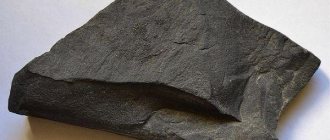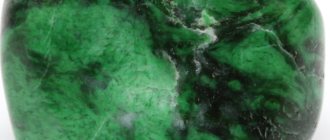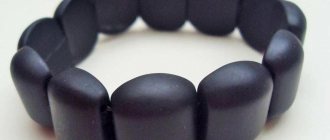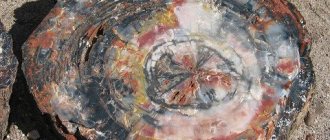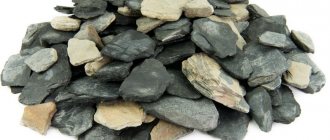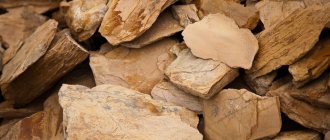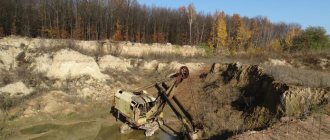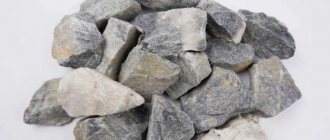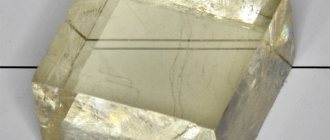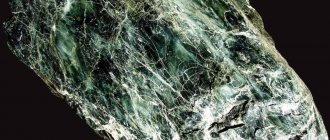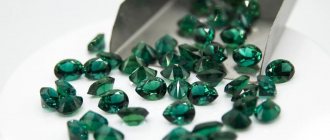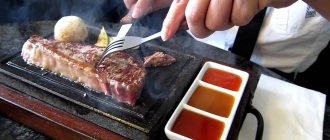Oil shale
Oil shale (OS) - pyrobituminous shale - sedimentary rocks of carbonate-clayey (marly), clayey or siliceous composition, containing 10-50%, rarely up to 60%, syngenetic sedimentation of organic matter kerogen.
GS have a brown, brown-yellow, gray, olive-gray color, leafy or massive texture.
Shale formations are rocks consisting of clayey limestones and silica, which are saturated with organic matter (OM). These are the main oil source rocks in almost all oil and gas basins of the world. The term "Oil shale" is sometimes used to designate all high-ash solid caustobioliths containing organic substances of various origins and various transformation conditions (carbonaceous, bituminous and liptobiolite shales). Kerogen-syngenetic organic substance with sedimentation with a high yield of resins during dry distillation, with a limited yield of bitumen, extracted with organic solvents at low temperatures. It is rich in hydrogen and its content is closer to oil than to coal. Geologically, kerogen is proto-oil; its content in oil shale ranges from 10% to 60-80%. The starting material for the organic matter of oil shale was the biomass of predominantly lower algae (sapropelic components), to a lesser extent higher plants (humus components) and partly animal organisms. According to the ratio of sapropel and humus components, HSs are divided into: sapropelites (HSs of the Baltic shale basin, Volga basin and Boltysh deposit),
saprohumites (menilite schists of the Carpathians). A distinctive genetic feature of the organic matter of most hydrocarbons is its accumulation in bottom sediments under normal oxygen conditions. The organic matter of HS is characterized by a high hydrogen content (7-10%), a high yield of volatiles during thermal processing (up to 90%), and a high specific heat of combustion (Qbdaf = 29-37 MJ/kg). The main mineral components of the GS are calcite, quartz and clay minerals; feldspars, pyrite, and accessory minerals are of subordinate importance.
What is slate
Slate stone (in other words, flagstone) is a sedimentary rock of volcanic origin, consisting of clay minerals, which is characterized by a wide variety of colors and reliefs. It is formed during the process of compaction and crystallization of clays at great depths.
The color of the stone depends on the presence of minerals and impurities of various chemicals. The most common flagstones found in nature are golden, yellow, brown, purple, gray, green and black.
Slate differs from other stones in its layered structure, which allows it to easily split into thin layers and plates. Often large blocks and slabs are used in their natural form.
What is oil shale?
Oil shale is a type of sedimentary rock that can be used to extract oil, the difficulty of extracting it has historically made it unconventional for the oil and gas industry.
Despite the similarity of names, shale is different from "shale oil". The latter refers to pockets of gas or liquid oil that occur in shale formations such as the Bakken Formation, which extends between North Dakota, Montana, Saskatchewan and Manitoba.
Shale oil - oil of 2 types (according to the classification accepted in the USA):
- Shale oil is a highly viscous shale resin that is significantly different in density and viscosity from traditional oil. Obtained from oil shale after thermal exposure;
- Tight oil - light oil contained in dense, low-porosity and low-permeability reservoirs
The search for shale oil requires new technologies because hydrocarbons are present without a visible seal, are not confined to uplift and without the classic gas-oil-water contact.
Light oil
Light oil (also known as shale oil, shale oil or low-permeability light oil) is light crude oil found in ultra-low permeability oil-bearing formations, often shales or tight sands, but with high oil saturation.
Commercial production from tight oil reservoirs requires the same hydraulic fracturing (fracturing) and often uses the same horizontal well technology as shale gas production.
Although shale oil is sometimes called "shale oil", recently oil shale and shale hydrocarbons have been distinguished
Oil shale is a rock saturated with kerogen, a precursor to oil.
The International Energy Agency (IEA) now recommends using the term “light tight oil” for oil produced from shale or other formations with very low permeability.
Previously, a 2013 World Energy Council report used the terms “tight oil” and “shale rocks.”
Oil and gas bearing shale formations are heterogeneous and vary greatly even over relatively short distances.
Low-permeability reservoirs after hydraulic fracturing can be divided into 4 groups:
- have low matrix porosity and permeability, resulting in cracks dominating both the storage vessel and fluid flow paths;
- have low matrix porosity and permeability, but the matrix provides capacity while the fractures provide fluid flow paths.
- have reservoir microporosity with high matrix porosity but low matrix permeability, which ensures the predominance of induced fractures in fluid paths;
- have macroporous reservoirs with high matrix porosity and permeability, which provides both capacity and flow paths, and fractures only increase permeability.
Due to the variability of well production, it is difficult to evaluate the results and make decisions regarding the profitability of wells. Producing oil from tight reservoirs requires at least 20% natural gas in the reservoir pore space to drive the oil to the wellbore. Hard-to-recover reserves in a reservoir containing only oil may not be economic to extract. Formations that form in marine environments contain less clay and are more brittle, and are therefore more suitable for hydraulic fracturing than formations formed in fresh water, which may contain more clay. Formations with more quartz and carbonate are more fragile.
According to various estimates, the reserves of oil shale and shale oil in the world are estimated at 650 trillion tons, which contain 550 - 630 billion tons of shale resin (artificial oil), which is even more than the proven reserves of natural oil.
Natural natural stones and their areas of application in construction, architecture, design
Natural stones are used in many areas of life. Granite, mica, slate and labradorite are used in construction and facing work, and flint, mirabilite and gypsum are used in medicine. The development of sculptural art and painting would have been impossible without marble, cinnabar and graphite, and agriculture would not have been able to function without limestone. Diamonds, sapphires and quartz are used in instrument making. These and many other types are used in architecture, design, decorative and jewelry purposes.
Marble
Marble is a metamorphic rock consisting primarily of calcite and admixtures of organic compounds. Easily processed. The stone comes in various colors, thanks to which it is successfully used in sculptural art, the furniture industry, and interior cladding. The disadvantages of marble include high cost and vulnerability to acidic environments.
Marble
Granite
Granite is an igneous hard stone of acidic type, replete with various colors and patterns. Composed of quartz, plagioclase, potassium spar and biotite and/or muscovite. Resistant to adverse environmental factors. It is used for cladding walls and slabs, making monuments, and building roads. The disadvantage of the material is its significant weight, which requires additional measures when working with it.
Granite
Limestone
Limestone is a sedimentary rock of biogenic, sometimes chemogenic origin, consisting of calcium carbonate. It is formed in large quantities at the bottom of oceans and seas. Limestone is used to make tiles and crushed stone, and limestone blocks are used in the construction of buildings. Eco-friendly, easy to process. The disadvantages are low moisture resistance and low load-bearing capacity.
Marly limestone
Pelitomorphic limestone
Sandstone
Sandstone is a sedimentary rock of clastic type, consisting of sand grains bound by mineral matter. It is almost as hard as granite. Depending on the color, it is used for decorative purposes; it is also used for the production of facing tiles and pouring foundations. Quartz sandstone is used to make glass. Disadvantages include heavy weight and lack of hygiene.
Feldspar-quartz sandstone
Quartz sandstone
Slate
Shales are rocks with a layered arrangement of minerals such as chlorite, actinolite, serpentine, quartz and muscovite. It is a product of volcanic activity. Physical properties depend on the composition. Various types of slates are used for the production of sand-lime bricks, crushed stone, cladding, and asphalt. Disadvantages of slates: dull color palette, high cost, heavy weight. Falls apart when subjected to physical impact.
Crystalline garnet-two-pyroxene schist
Crystalline shale hypersthene-plagioclase
Travertine
Travertine, or calcareous tuff, is a fine-grained rock formed from calcium carbonate. It is distinguished by its low weight and hardness, porous structure. Travertine tiles are used for both interior and exterior decoration. Also used for liming soil in agriculture. The disadvantages include the fact that it requires careful and regular care.
Travertine
Basalt
Basalt is a basic type of igneous rock consisting of plagioclase, clinopyroxene, magnetite and volcanic glass. Can change its structure due to hydrothermal processes. It is characterized by high strength and ductility, which allows the use of basalt in the production of insulating materials, slabs and mineral sheets. It is the most common igneous rock. The disadvantages include the high price.
Basalt
Basalt
Labradorite
Labradorite is an igneous intrusive rock of the main type, consisting of plagioclase - labradorite with admixtures of pyroxenes and ore minerals. High-quality facing stone, used for decorative purposes and monumental architecture. It has high strength and weather resistance. The disadvantage is the high cost.
Labradorite
Flint
Flint is a sedimentary rock with high hardness. It is a type of quartz, consisting of crystalline and amorphous silica. Able to change color when mixed with other rocks. At the dawn of mankind, it was used for striking fire and making tools. Currently used for road construction and decorative purposes. There are no disadvantages.
Flint
Flint
Flint
Main characteristics of slate
Natural slates are composed of different minerals. The rock was formed under high pressure and exposure to different temperatures.
The advantage of the breed is:
- Resistant to moisture.
- Fire resistance.
- Immunity to natural factors.
Their formation occurred several million years ago during the period of movement of tectonic plates, volcanic eruptions and geysers. The slates are based on dark-colored stones with particles of silicon and feldspar. Some rocks contain mica.
Slate rock: description, origin, properties
Slate rock photo
Slate is a rock that is several hundred million years old.
The formation of this mineral occurred either in the bowels of the earth as a result of active volcanic processes, or deep under water, when silt and clay formations that sank to the bottom were compressed under high pressure.
Natural slate consists of plates, the structure of which contains quartz inclusions and feldspar particles. Mica schists are distinguished by the presence of mica in their composition.
Depending on what underlies it, rocks can exhibit different physical properties.
For example, different samples may show completely different levels of hardness. Some of them score 2 on the Mohs scale, while others score 6.
The natural mineral also has different thermal conductivities. So, there are rocks that burn well, and there are absolutely fireproof ones.
The same applies to indicators such as water resistance and resistance to various external influences.
Shale deposits are distributed throughout the world. Particularly large deposits have been found in North and South America, in some countries of Europe and Central Asia. On the territory of the Russian Federation, production is mainly carried out in the Siberian region, the Urals and the North Caucasus.
Deposits in Russia and the world
The largest shale deposits in the world are located:
- Mongolia;
- countries of Central Asia;
- China;
- Canada;
- USA;
- Brazil;
- Kazakhstan;
- central Europe;
- Republic of Belarus;
- Estonia;
- Ukraine.
On the territory of the CIS countries, the largest deposits are the Volzhskoye, Pribaltiyskoye, Kenderlykskoye (Kazakhstan), and the Arctic.
The main deposits in Russia where mineral extraction takes place:
- Siberia;
- Ural (Ekaterinburg);
- Leningrad region;
- Kirov region;
- Kostroma region;
- Komi Republic;
- Chuvashia;
- North Caucasus.
Where and how is the rock mined?
Shale deposits are found in different countries. The most common types of shales are clayey and crystalline. Deposits are being developed in a number of Asian countries, the USA, Brazil, Central Europe, Belarus, and Estonia. In Russia, slate stone is mined:
- in the Urals;
- in Siberia;
- Leningrad, Kirov, Kostroma regions;
- near Yekaterinburg;
- in Mordovia, Chuvashia, and the North Caucasus.
Chlorite shales are the least common variety. However, one of the largest deposits of this rock was discovered near the Ural Mountains. There are also deposits of these minerals in other countries:
- in Austria;
- on the Australian mainland;
- on the British islands;
- in Turkey;
- on the island of Madagascar;
- in South Africa;
- on the American continent;
- in China.
Large-scale oil shale development is underway in Canada and the United States. Rock is mined using two methods:
- Open or career. At the location of the mineral deposit, the upper layers of the earth are removed. After the stone monolith is opened, trenching begins. Lumps of material are broken off using special tools and loaded onto vehicles. As rock is removed, quarries of varying depths are formed. This is the most environmentally friendly mining method.
- Underground. Most often used to extract oil shale and shale gas. The method involves drilling deep wells using expensive and complex equipment, and is therefore very expensive. Underground mining carries a high risk of environmental pollution. This method can only be used in areas remote from populated areas, forests and water resources.
Types of slate
Shales vary in composition and are divided into the following types:
- crystalline schists - the composition is dominated by mica and quartz, often of a gray tint, this also includes biotite schist with a predominance of black mica-biotite, they have medium hardness, low thermal conductivity and high heat resistance;
- siliceous rock - consists of dense plates with chalcedony and quartz grains. Depending on the impurities it has different colors. Solid in density, with a low level of moisture absorption, not sensitive to temperature changes;
- oil shale - the name speaks for itself, is highly flammable, has average density, looks like hardened clay, and when burned, produces a pungent odor and soot;
- clay shale is a dark-colored mineral, hard, resistant to high temperatures, insoluble in water, with inclusions of clay particles, chlorite and hydromica, emits a clayey odor when wet;
- chlorite slate - due to the chlorite content, the stone has a green color with a shiny surface, brittle, non-flammable, with a high ability to absorb sounds;
- slate slate is a soft mineral of a gray hue, easily layered into columns;
- artificial slate.
Types of stone by origin
The most important criterion for classifying rocks is the type of origin. There are three main methods of stone origin:
- magmatic – primary, or endogenous;
- sedimentary – secondary, or exogenous;
- metamorphic - transformation of igneous or sedimentary rocks under the influence of external factors.
Igneous origin
Rocks of igneous, or endogenous origin, are formed as a result of the solidification of lava. The final structure of the stone depends on its composition, cooling rate and atmospheric factors. There are two types of magmatites:
- Intrusive. Magma gradually solidifies deep underground, putting enormous pressure on the rock. As a result, dense and massive crystallized blocks are formed, practically free of pores and voids.
- Effusive. Lava solidifies on the surface or in the upper layers of the earth through a volcanic eruption, and solidification occurs at low temperatures and occurs unevenly. Such rocks are more fragile and porous, and they often contain cracks.
During the eruption process, hot magma passes through other compounds and dissolves them into itself. According to their chemical composition, igneous rocks are usually divided into:
- acidic - silicon dioxide content more than 65%, with impurities of potassium and sodium;
- medium – 54-65% silicon dioxide, in the presence of aluminum and calcium;
- the main ones are silicon dioxide in the range of 45-54%;
- ultrabasic - less than 45% with a significant content of iron and magnesium.
Sedimentary origin of rocks
A stone of sedimentary or exogenous origin is formed during the destruction of rocks by external factors - atmospheric phenomena, temperature changes. They are found everywhere on the surface of the earth, spreading by currents of air and water. They often accumulate at the bottom of reservoirs, then settle and become compacted. There are the following subspecies:
- clastic – formed from parts of igneous origin;
- biochemical - formed due to the mixing of organic and inorganic compounds;
- chemogenic - consist of deposited sediments of concentrated solutions;
- biogenic - are the ossified remains and waste products of animal and plant origin.
Biogenic and biochemical sedimentary rocks form combustible substances such as coal, shale, peat, and oil.
Metamorphic rock formation
Metamorphic rocks are formed by transformation from other types of rocks. This occurs due to exposure to high temperature, pressure, and chemically active substances. The minerals that made up the primary rock are broken down by factors and then assembled into other compounds that form metamorphic rock. For example, clay, under the influence of metamorphism, turns into shale, and quartz sandstone into quartzite.
Depending on how intense the metamorphic transformation process was, it is not always possible to accurately determine which rock was the primary one. According to the conditions of formation of such rocks, the following types are distinguished:
- Regional. They are formed when lithospheric plates shift, when one mineral rock penetrates deep into another. Accompanied by strong pressure and high temperature.
- Hydrothermal. Occur with the direct participation of underground hot springs. Due to strong heating, the components that make up the rock enter into a chemical reaction and are converted into other compounds.
- Contact. They are formed near intrusive-type magmatites under the influence of high temperature on individual layers of the earth's crust. A distinctive feature of this type of metamorphism is the formation of large mineral crystals of high strength.
Meteorites - space rocks
About two thousand tons of cosmic rock fall to Earth every year. In most cases it consists of silicates such as olifin, fayalite, forsterite, pyroxene, ferrosilite and enstatite. Meteorite formations are predominantly chondriacal in appearance, and their composition is similar to that of the Sun, with the exception of hydrogen and helium. It is likely that rock-type meteorites are formed from the protoplanetary cloud surrounding the Sun through the gravitational attraction of dust and condensation of substances. Used in jewelry and decorative purposes.
Types of slate and their properties
The name “slate” combines many natural stones of different composition and properties, which can be divided into thinner layers. They are divided into groups depending on their composition and general characteristics. Each variety also has several subspecies.
The table provides a brief description of the different shale rocks:
| Group | General characteristics | Characteristic properties | Varieties and their descriptions |
| Clayey | Formed from mineral deposits with various impurities. They can be based on: sericite, quartz, chlorite. Color – black, brown, greyish, green, red. |
|
|
| Crystalline | Stones formed from mica and quartz. Most often they have gray shades. |
|
|
| Siliceous | They are formed from quartz or chalcedony with clay admixtures. The color depends on the amount and characteristics of impurities. There are red, green, purple, black and gray shales. |
|
|
| Chlorite | The basis of the rock is chlorite. The stones are green in color, shimmer, and have a shine. |
|
|
| Flammable | In appearance they look like frozen clay. The color of the rock is yellow, gray and dark gray. |
| They can be divided according to the principle of territorial location and the impurities included in them. |
White
White slate or “alpine” is a rock consisting of layers of plate-like minerals. The composition is dominated by gypsum, so the decorative stone is endowed with such qualities as:
- thermal insulation;
- durability;
- ease;
- strength.
It is resistant to sudden temperature changes, although it is fragile due to its layering. You need to work with it very carefully.
From plaster
Artificial slate made from gypsum has one significant drawback: it can only be used in dry rooms. Gypsum cannot withstand high humidity, as it quickly absorbs moisture and swells.
Advantages:
- ease;
- strength;
- heat capacity.
Important: You can make gypsum tiles yourself by choosing suitable molds for production. Read about pouring decorative stone with your own hands here.
weathered
Weathered is an artificially created material , its texture is very similar to a natural mineral due to its relief chipped surface.
Advantages:
- low price;
- light weight - installation is faster and easier;
- resistance to physical and chemical influences;
- ease of processing - does not crumble, does not delaminate;
- variety of colors and textures.
Classical
Classic material - not too embossed, moderately porous, not bulky. It can be used in any interior. Most often it is used for cladding a large room.
If you need to cover an entire wall, then classic slate with its fine texture is ideal for such a design solution.
Advice: A surface lined with such material will harmonize well with a flat, smoothly painted wall, which will emphasize the beauty and simplicity of the stone.
Large
Decorative slate with a pronounced texture in the interior looks impressive and unusual. Large relief and large differences create a spectacular design. This stone is made from gypsum (for interior work) or cement.
Thin layer
Sheet shale is a rock that has been fractured into thin sheets. They are stacked one on top of the other, with the end of each element visible on the decorative surface. In contrast to the sizes and proportions of other types of elements, the thin-layer material is small in size, with a more pronounced relief and sharp corners.
Types of classification of natural stones and minerals
Natural stones and minerals are classified according to their type of origin, composition, hardness, transparency, value and other properties. There are monomineral rocks, consisting of one mineral, and polymineral rocks, consisting of two or more minerals.
In order to distinguish valuable species from decorative ones, various classifications have been compiled. The most relevant of them is the classification of Bauer and Kluge, which includes precious and jewelry stones. The mineralogist Fersman made a significant contribution to its development, adding division into groups and classes.
Other classifications:
- on optical characteristics - compiled by Georg Gurich in 1902;
- at market value - proposed by Evgeny Kievlenko in 1973;
- according to physical and chemical characteristics - created by the All-Union Scientific Research Institute of the Jewelry Industry in the 80s of the 20th century.
Artificial
Artificial decorative stone imitation slate differs from natural stone in the following parameters:
- Weight. The lighter the cladding, the easier it is to install. Even a beginner can lay out a wall or some kind of pattern with artificial stone, but to work with natural material, you will most likely have to turn to a professional craftsman.
- Affordable price of an artificial analogue.
Fragments imitating shale rock are produced:
- Made from cement. Cement-based finishing material is universal. Cement has a low price, and products made from it are strong and durable. To make cement fragments, you need a cement mortar and a polyurethane mold that replicates the slate surface.
- Made from plaster. Decorative gypsum material is made from pure G5 grade gypsum, slaked lime, and dye. To make elongated, oblong elements, you will need to purchase a special mold.
For beginners who do not want to deal with mixing cement or gypsum mortar, ready-made dry mix “Kamnedel” is produced.
Read about the production and use of decorative stone from gypsum here, and find out how to make decorative stone at home here.
Application of slate stone
Slate building stone
Natural slate has long been actively used as a finishing material in the construction of buildings, in landscape design, and for the interior decoration of houses. For example, siltstone shale, the development of which began in the 19th century, was used in the construction of St. Isaac's Cathedral in St. Petersburg. Siltstone plates have a unique color (beige-burgundy, sometimes pink) and an interesting texture.
Crystalline varieties of the rock perform well as a building material. They withstand low temperatures and withstand exposure to ultraviolet rays. This material is very strong and will last a very long time. In addition, it has high sound insulation and excellent heat retention in the room.
Oil shale is used not only as fuel, but also as a raw material for the chemical industry. It is distinguished by its low density and a variety of color options (from gray-yellow to black). However, the active use of this material is hampered by a rather expensive extraction process, attempts to improve which do not stop.
Scope of application of flagstone
Slate stone has excellent physical and aesthetic characteristics, therefore it is actively used for both external and internal repair work. Thanks to its flexibility and pliability, the material is actively used in landscape design.
Tiles made of slate are suitable for cladding facades, gazebos, flower beds, stairs and other external surfaces. Thicker products are used for paving garden paths and as cladding for sidewalks.
It should also be mentioned that slate stone is ideal for interior decoration. Its slabs are used to lay luxurious flooring and decorate doorways, arches, walls, bar counters and other surfaces. We also manufacture countertops, window sills, sanitary ware and a host of other interior items.
The crystalline mineral is characterized by high strength and does not absorb moisture, which is why it is widely used as a roof. This roof covering does not lose its original appearance for a long time, since its special structure promotes self-cleaning of the surface.
Fireproof options are used for the manufacture of stoves and fireplaces. Combustible varieties serve as excellent fuel for heating homes.
Dishes made from slate are especially popular. It is distinguished by its impressive appearance, resistance to damage and hygiene.
In crushed form, stone particles are used to fill concrete, produce wall blocks and apply a reinforcing layer to the surface of roofing material.
Where is it used?
Slates are in demand by industry, decorators, and stone cutters. The scope of application is determined by the characteristics of the raw materials.
Industry
Oil shale is a source of hydrocarbons and raw material for the chemical industry. They are easy to distinguish by their gray-yellow to black shades and low density.
Natural crystalline slate is used as a building material that requires minimal processing.
The stone is valued for many properties:
- Reliability. Walls and roofs made of slate can last for decades. If the installation technology is followed, the roof will not leak or crawl. The mineral is indifferent to natural disasters, temperature changes, heat, cold, and corrosion.
- Houses made of fire-resistant slate are completely fireproof.
- Aesthetics. Slate coating does not “shed” from rain or sun.
Slate (especially crystalline) retains heat, which is of particular importance in regions with harsh climates. And the stone muffles noise just as well.
Decor
Designers love stone for its variety of shades, textures, and texture.
Artificial slate
Decorative stone slate becomes a tabletop in the interior, cladding walls, floors, fireplaces, stoves, and large architectural forms. It looks noble and is beneficial because it retains warmth and privacy.
Slate in the interior
In landscape design these are paths, paths, alpine slides, garden and house compositions.
Other areas
Dishes and items with esoteric themes are made from slate.
And also pendants, bracelets, beads. This decoration is suitable for youth, ethnic, boho and similar clothing styles. You can minimally care for the stone.
The healing properties of slate
In addition to its qualities, which are used in various fields of industry and construction, slate also has some healing properties.
It has long been noticed that if you are in a room decorated with this material, your nervous system calms down, your well-being improves, and stress is relieved.
If you heat a piece of such a stone and apply it to a sore spot, the unpleasant symptoms will go away. In addition, it is useful to drink water infused with it.
Healing and magical properties of the stone
Supporters of traditional medicine claim that black slate has a positive effect on the functioning of the human body. Dwellings made from this material become a real temple for people: the stone relieves nervous tension, eliminates nightmares, and restores the energy background.
Healers and light magicians connect gray slate with the Cosmos. The mineral receives signals from the Universe, processes them and transmits them to its owner. The stone helps to interpret dreams and opens the talent to see the future. To set up a mineral to work, the owner needs to spend a lot of time with it, mentally ask it questions and thank it for its help. Clay shale has particular power during the full moon and church holidays. Mica also has magical properties. She is able to attract wealth and treat serious illnesses.
Slate stone has a beneficial effect on people whose professional activities are related to creativity. These could be writers, writers, philosophers, artists and musicians. In addition, shale often becomes an assistant in performing magical rituals for psychics and magicians.
Dominant sign - Pisces. Representatives of this sign need outside support and self-confidence. Mica slate will charge them with vital energy and give them strength to translate the most unusual ideas into reality.
Understanding Oil Shale
To extract and process oil shale, sedimentary rocks must first be removed using surface or underground mining. These raw materials must then be sent to various processing plants to extract the kerogen contents. During the extraction process, some of these raw materials may have low levels of kerogen deposits.
Some processing methods, known as "ex situ processing", involve mining a deposit of kerogen and then transporting it to a separate facility for processing. Other methods, such as "in-situ processing", involve extracting kerogen from the mine itself.
The United States contains the largest oil shale deposits in the world, most of which are located between Colorado, Utah and Wyoming in the so-called Green River Formation. Other active oil shale producers include the United States, Russia, Germany and China. Historically, Estonia has also been a major producer of oil shale due to the country's large reserves. Despite the abundance of oil shale in the United States, the costs associated with extracting kerogen from rocks make the process generally an environmental concern.
Oil shale is typically used in situations where the price of conventional crude oil becomes prohibitive—often as a result of temporary supply disruptions or geopolitical issues.
Sources
- https://neftegaz.ru/tech-library/energoresursy-toplivo/141700-goryuchie-slantsy-slantsevaya-neft/
- https://nesrakonk.ru/shale/
- https://altenergiya.ru/poleznaya-informaciya/kak-obrazuyutsya-i-primenyayutsya-goryuchie-slancy-osnovnye-mestorozhdeniya-v-mire-i-rossii.html
- https://MoyKamen.com/vidy/prochie/slanec-kamen-chto-eto.html
- https://okcomfort.com/steny/decorativnii-kamen/slanec.html
- https://Karatto.ru/podelochnye-kamni/slanets.html
- https://jgems.ru/podelochnye/slanets
Price
Despite the abundance of positive qualities, not every property owner decides to use slate as a finishing material. The stone, the photo of which you saw in this article, is considered an elite material, and therefore has a fairly high price.
The cost of the simplest facing flagstone starts from 600 rubles per 1 m2. Rarer varieties will cost several times more.
The minimum cost of roofing tiles measuring 40 x 40 cm is 200 rubles per piece. Although, if you consider that such a coating can last more than 200 years, we can conclude that this investment will be justified.
In conclusion, I would like to note that, in addition to all the above advantages, slate has a healing effect on humans. It helps relieve stress, promotes relaxation and normalizes sleep. Therefore, by purchasing this material, you can not only decorate your interior, but also take care of the health of the whole family.
